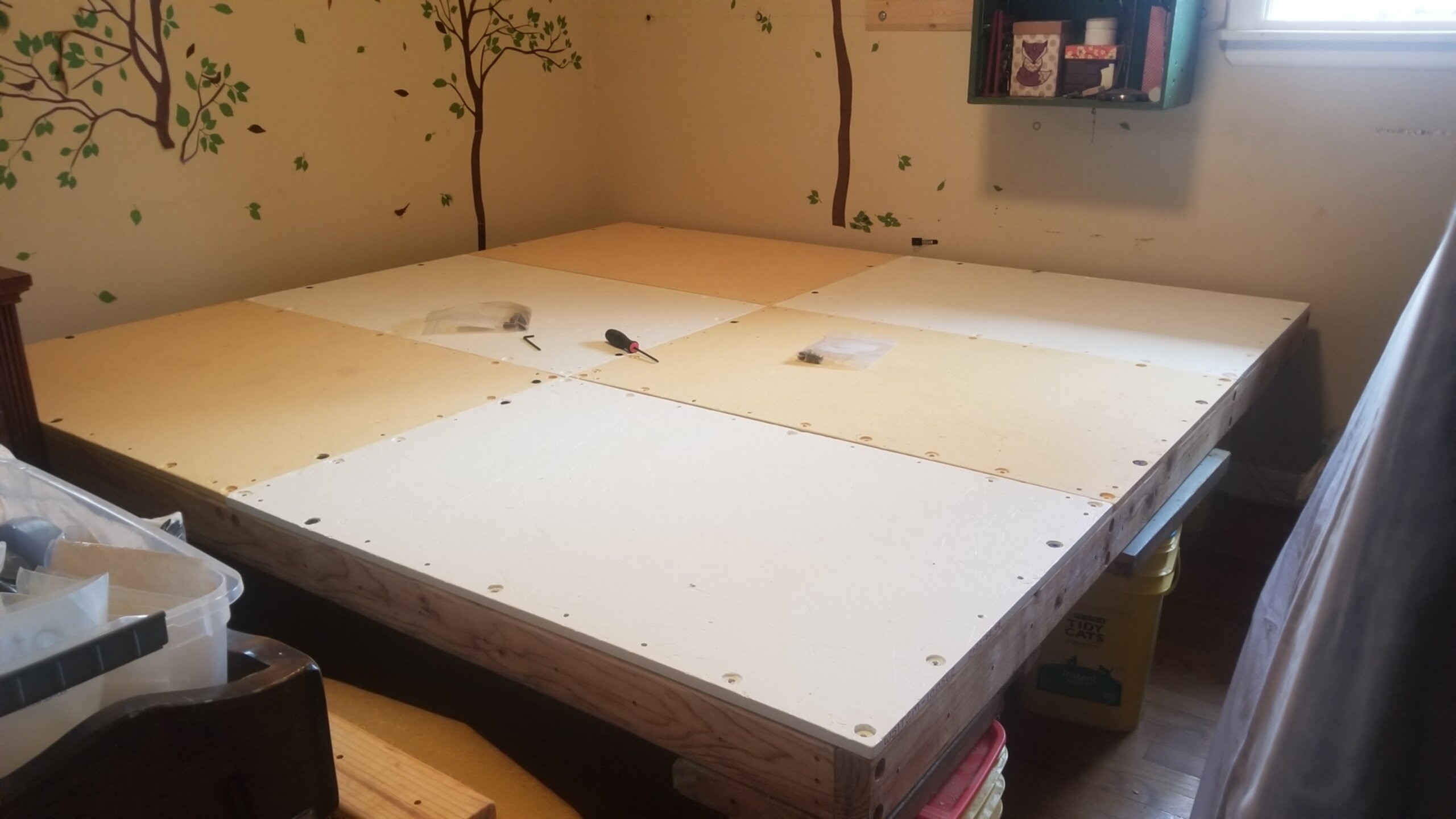After about a month and a half of work (and waiting for paint to dry), I have finally finished building a new frame for our king-sized mattress.

Design Overview
An 81″×81″ frame made from two 81″ two-by-fours, four 78″ two-by-fours, two 24+¾″ two-by-fours, one 25+½″ two-by-four, and six 27″×40+½″×⅝″ OSB panels.
The framing is held together entirely with ¼″-20 furniture bolts which pass through counterbored holes in the broad sides of the beams into cross dowel nuts in the end of the adjoining beams. The 81″ beams form two sides, the 78″ beams are attached between those, and the shorter beams are flat and flush with the top of the frame to give something for the panels to connect to in the middle of the bed. The beams around the edges and the flat ones in the middle all have threaded ¼″-20 holes every 4+½″. (See entry 26 for the significance of 4+½″ hole spacing.)
The top panels have mounting holes around the edges, also every 4+½″, plus in the corners. Every third hole is counterbored, as are the corner ones.
The beams were given a coat of boiled linseed oil. The panels were painted with various types of primer, sanding sealer, glue, and paint that I found lying around.
The whole thing rests on cat litter bins topped with recycled stairs (my parents recently had their stairs replaced; I rescued the cut-up pieces from a dumpster). I considered making proper legs, but worried about torque that might be applied accidentally while moving the bed around, and wasn't able to come up with anything as strong and simple as just stacking it on stuff.
Commentary
The point of this, to anyone who is very confused about why I would put so much effort into a dumb bed frame when I could have just gone and bought one, or built something in an easier way (i.e. slap something together with constructon screws), is to have a structure that can be repeatedly disassembled and reassembled, and whose parts are small enough to carry and fit in the car, and 'standardized' enough that they can be independently replaced, and eventually repurposed when the structure as a whole has outlived its usefulness. 27″×40+½″ may seem like very strange and non-standard dimensions on first glance, but if you accept 1+½″ (the thickness of a two-by-four) as your base unit and 3 as your favorite multiplying factor, they are arrived at easily, especially if your goal is to cover an 81″ square while making relatively efficient use of 4′×8′ panels. 27 = 1½×3×3×2, and 40+½ = 1½×3×3×3.
King-sized mattresses are annoyingly almost-but-not-quite square, at 76″×80″. An 81″ square was chosen for the frame size because it's a nice multiple of my preferred base unit, the 4+½″ cube, and is only slightly larger than it needs to be to hold the mattress. The remaining 5″ along one side can hold, like, a small shelf for books or water bottles or whatever.
The holes that need to be drilled for cross dowel nuts are kind of a pain to get just right. Because the hole that the bolt passes through on its way to the nut needs to be small enough that the nut doesn't pull out, small misalignments lead to trouble. Several of the ones I drilled were off-center and had to be widened. Even when the nuts are installed perfectly and the tunnels to them perfectly straight, it can be tricky to get the bolts lined up. I might just use glue-reinforced threaded inserts next time I need to bolt into the end of a board.
It was probably a waste of time to counterbore any of the panel mounting holes. The heads of the furniture bolts that I use are only about 3⁄32 thick, which wouldn't bother the bottom of my mattress too much. It's tricky to drill the counterbores using a handheld drill (the alternative, which would have been to try and hold the panels under the drill press wasn't very appealing, either), and the counterbores also complicate paint application.
Due to two-by-fours being a non-multiple-of-1½″ wide, the pattern of bolt holes in the their sides and ends that join the veritcally-oriented ones together is 'not quite gridbeam-compatible', though any of the three rows of holes could be. This pattern, where the top and bottom rows are 1" from center, i.e. 3/4" from each edge, was later standardized as WSTYPE-4129, and is, as of 2023-01-23, the best compromise that I have been able to come up with between gridbeam compatibility, simplicity, and making the best use of two-by-fours.